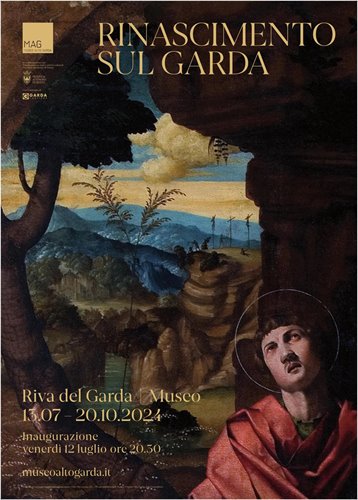Zenone Veronese (Verona, 1484 - Salò di Brescia, 1542 c.)
San Sebastiano e San Cristoforo
Zeno Veronese (or Zeno from Verona)
(Verona, 1484 - Salò (Bs) after 1542-before 1554)
San Sebastiano and San Cristoforo
Oils on canvases
173 x 55 cm
Exhibition: Rinascimento sul Garda (12/07/2024 - 20/10/2024) - MAG MUSEO ALTO GARDA - MUSEO RIVA DEL GARDA
This pendant of works has been declared of particularly important historical and artistic interest by the Ministry for Cultural Heritage, Superintendency of Verona (decree of 22 January 2022).
Exhibition: Rinascimento sul Garda (12/07/2024 - 20/10/2024) - MAG MUSEO ALTO GARDA - MUSEO RIVA DEL GARDA
This pendant of works has been declared of particularly important historical and artistic interest by the Ministry for Cultural Heritage, Superintendency of Verona (decree of 22 January 2022).
In the in-depth historical-artistic report drawn up by the Ministry, following the careful material and stylistic analysis carried out and further specific investigations, the two proposed paintings, depicting San Sebastiano and San Cristoforo, are assigned to Zenone Veronese (Verona, 1484 - Salò di Brescia, after 1542 / before 1554).
The two paintings in question, depicting San Sebastiano and San Cristoforo, are painted on herringbone canvas, a particular textile support of Venetian painting. The arched shape allows us to hypothesize with certainty the location in a religious building and that they were originally the side panels of a polyptych, probably a wooden frame (lost), which bore in the center the effigy of a saint or of the Madonna that could have been painted or carved. A later and updated variant of the Cavriana triptych (1512) and chronologically very close to the one, commissioned by the Franciscan order, depicting the Eternal Father between two angels with Saints Joseph and Francis of Assisi (Salò, S. Bernardino, formerly in the oratory of S. Anna alle Rive) (Amaturo, Marelli, Ventura 1994, pp. 55-57, 108-102, nos. 1, 21). In fact, to date, only these two polyptychs made by Zenone Veronese are known as part of his artistic production.
Considering the posture of the bodies, the landscape, the play of light and the orientation of the gazes, San Sebastiano was placed on the left and San Cristoforo, who turns towards the outside of the canvas, on the right, in the typical act of involving the devoted bystander to join and participate in the sacred scene.
The stylistic analysis and the comparison with works of certain dating suggests that the two paintings can be traced back to the artist's maturity and dated between the end of the fourth and the first years of the fifth decade. The anatomical rendering of the nude of San Sebastiano is similar to that of the figures in the Descent to Limbo (Salò, Duomo) of 1537, while the face of San Cristoforo seems to be traced on that of San Rocco (Barghe, S. Rocco) of which it also echoes the majestic figure dressed in a short tunic and a large cloak.
The Saints are both immersed in a natural landscape, the arboreal wings and the mountainous reliefs that in the distance become blue under the sky crossed by long luminous streaks: it is a compositional structure adopted by Zeno also in the two large altarpieces of the Cathedral of Desenzano (1541) and the affinity is even more evident thanks to the comparison with the canvas depicting the Madonna with Child and the saints Cristoforo, Zeno, Antonio abate and Sebastiano di Padenghe (1542).
Despite the absence of documents relating to the provenance of the two paintings in question, it should be remembered that in 1878 in the new parish church of Bardolino, on the Veronese shore of Lake Garda, "two good paintings by Zanon of Verona" (Simeoni 1878, p. 146). The scholar erroneously indicated the dedication of the church, whose façade was still to be built, to S. Sebastiano, but it is certainly the new parish church dedicated to SS. Nicolò and Severo built on the site of the old church dedicated to S. Nicolò. The two canvases in question could hypothetically be identified with those cited by Simoni, probably coming from the ancient pre-existing building.
Having said this, it is believed that for the two paintings depicting San Sebastiano and San Cristoforo, of good executive quality, testimony of a dismembered and lost polyptych by Zenone Veronese and for the reasons expressed above, they are of exceptional cultural interest pursuant to art. 10, paragraph 3, letter e) of Legislative Decree 42/2004 and subsequent amendments







